The Terradrift giveaway is on! Enter here for a chance to win over $1,000 in outdoor gear!
Ever wanted to travel with your bike to a cool mountain bike (or gravel bike, or road bike) destination, but didn’t because you looked at the cost of renting a decent steed for the week and had a low-grade heart attack? We get it. For years, we thought the only way to travel with a bike was to make a road trip of it. Which can be a super fun time, especially if you have a solid, multi-functional bike rack like the Yakima Exo System, but sometimes, it’s just too dang far and you don’t have the time.
Fortunately, road trips aren’t the only option if you want to travel with a bike: you can absolutely fly with a bike, too. Yes, fly with your bike. As in, check it as luggage when you’re jetting from one destination to another on a commercial airline. Exciting stuff, right? So we’re gonna break down how to do it, what to expect, and then compare two excellent bike travel bags so you can take your bike with you the next time you fly to a place with gnarly single track to shred!
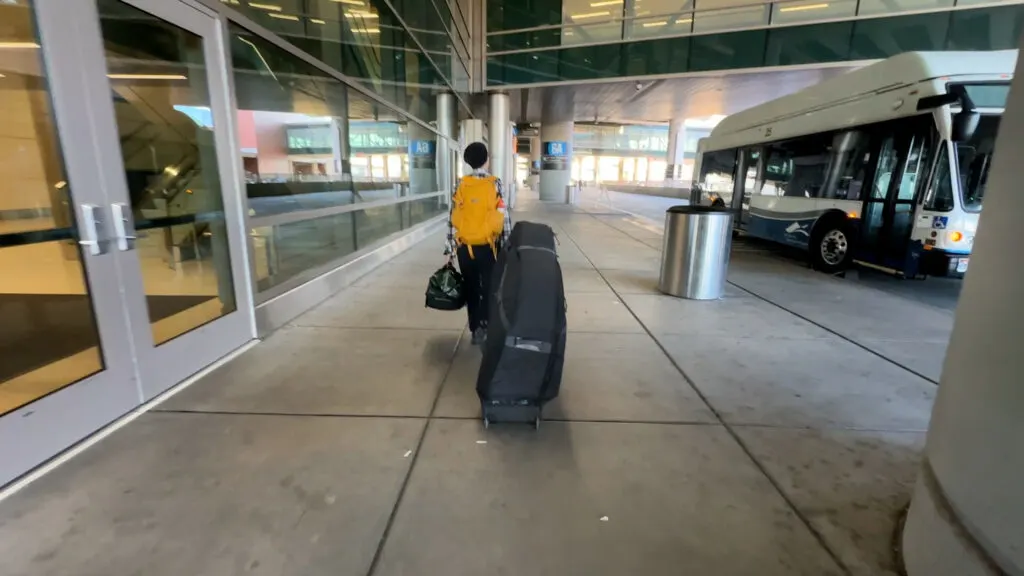
How to Travel with a Bike: Airline Restrictions when it Comes to Flying with a Bike
First of all, it’s important to know that you can’t just roll your bike into the airport, take it to the baggage check area and toss it on the scale. You’re going to need either a dedicated bike travel bag–like the two we’re going to talk about in a minute–or potentially even a bike box, like one a bike might have been shipped in (whether that was to you or a bike shop near you). Airlines require it.
Most airlines also treat bikes differently than traditional luggage and have different size and weight restrictions, which usually works in your favor. It means bikes have more wiggle room in the size department so you’re less likely to be charged extra. But you will want to look on your airline’s website before booking tickets for details about traveling with bikes. Details will typically be listed under “special items” or “sports equipment” in the area of the website that offers info about checked baggage. There, you’ll find details on whether oversized fees are waived for bikes, if there are different size restrictions, or if bikes cost extra, which they do on JetBlue and Hawaiian.
And while most airlines have bike-specific size restrictions that accommodate their larger size, weight restrictions are another thing entirely. The specifics depend on the airline, but in general, if your bike is heavier than 50 pounds, you’ll be charged an overweight fee. Which could be double or more the price of a typical checked bag. We’ll get into why that matters when picking out a bike travel bag in a minute. For now, here are some domestic airlines and their guidelines for checking a bike as luggage.

Airline Bike Restrictions
- Alaska: Oversize and overweight fees are waived. Regular checked bag fees apply.
- American: The usual checked baggage fees apply when checking a bike. There may be oversize or overweight fees.
- Delta: Normal baggage fees and overweight/oversize fees apply.
- Hawaiian: Depends on where you’re flying. Travel from one Hawaiian island to another with your bikewill cost $25. To or from anywhere elsecosyts $100. Overweight fees apply.
- JetBlue: In addition to a checked baggage fee, bikes cost $100 extra per direction of travel But there are no overweight or oversize fees.
- Southwest: As long as bikes fall within regular checked baggage dimensions you can check them for free like other luggage (up to two bags). If a bike is oversized or overweight there may be additional fees.
- United: Normal checked baggage fees will apply, including overweight fees.
What to Expect at the Airport
When you arrive at the airport with your bike appropriately packed, you’ll probably drop off your bike at the regular check-in counter and bag drop. But when you arrive at your final destination, you’ll probably pick it up on the oversized baggage belt. So don’t sit around waiting at the regular baggage carousel and panic when your bike doesn’t arrive. Go find the oversized area.

Don’t forget!
In addition to your bike, don’t forget the necessities for riding and re-assembling your bike once you arrive at your destination:
- Helmet (We love our Sena M1 Evo intercom helmets)
- Knee and elbow pads if necessary
- Torque wrench
- Multi-tool
- Portable tire pump
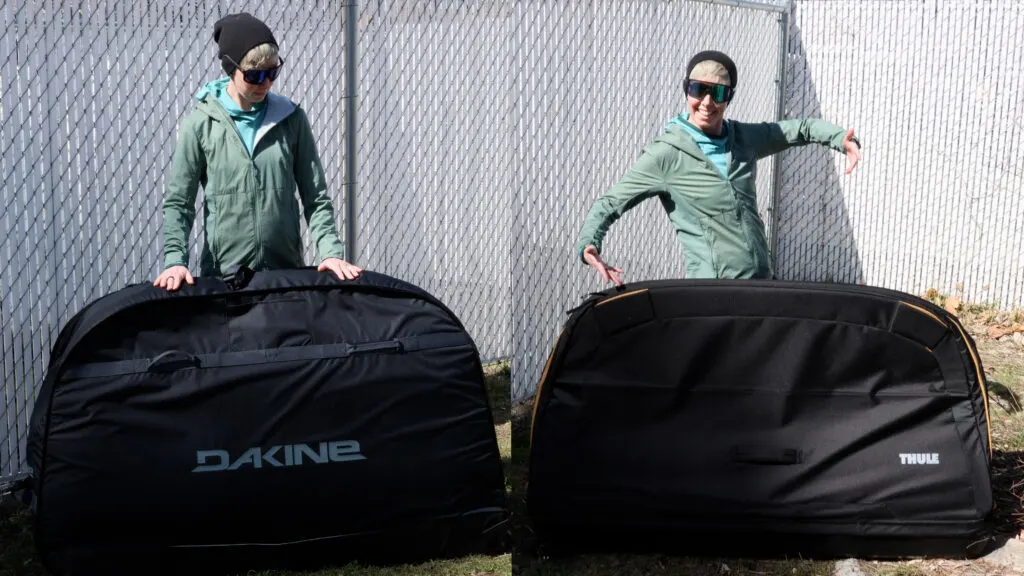
Types of Bike Bags for Travel
But let’s talk about bike travel bags. There are two main kinds: soft and hard.
Soft cases are pretty much what they sound like. The base will be rigid, but the sides and walls will be fairly flexible and just slightly padded. Soft bags are nice for a few reasons:
- They fold up to take up much less space in your garage or closet when they’re not in use.
- They tend to weigh less than hard cases.
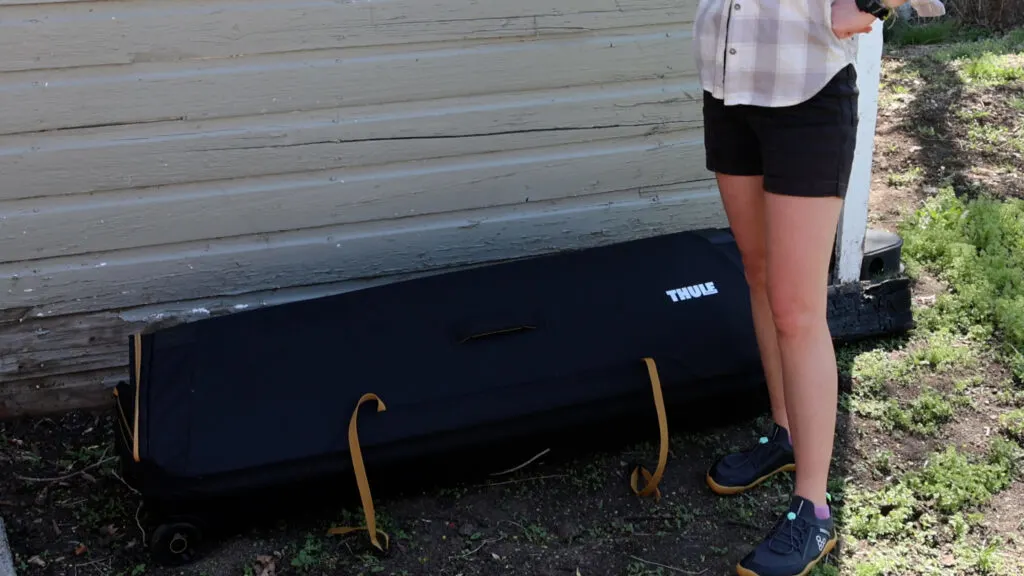
Then there are hard cases. Some people prefer these despite the fact that they take up more room when not in use and they weigh more for one reason:
- They are more protective. After all, It’s a lot harder to damage your bike when it’s in a hard-sided case when it’s getting tossed around luggage bays at the airport.
So if you have an especially nice or expensive bike, you may prefer the peace of mind that comes with the additional protection of a hard bike case, even if the weight of your bike and case together tip it over the overweight limit. But we tested two bags to see which we preferred, the Dakine Bike Roller Bag and the Thule RoundTrip MTB (both with mountain bikes, though there are also road bike versions available).
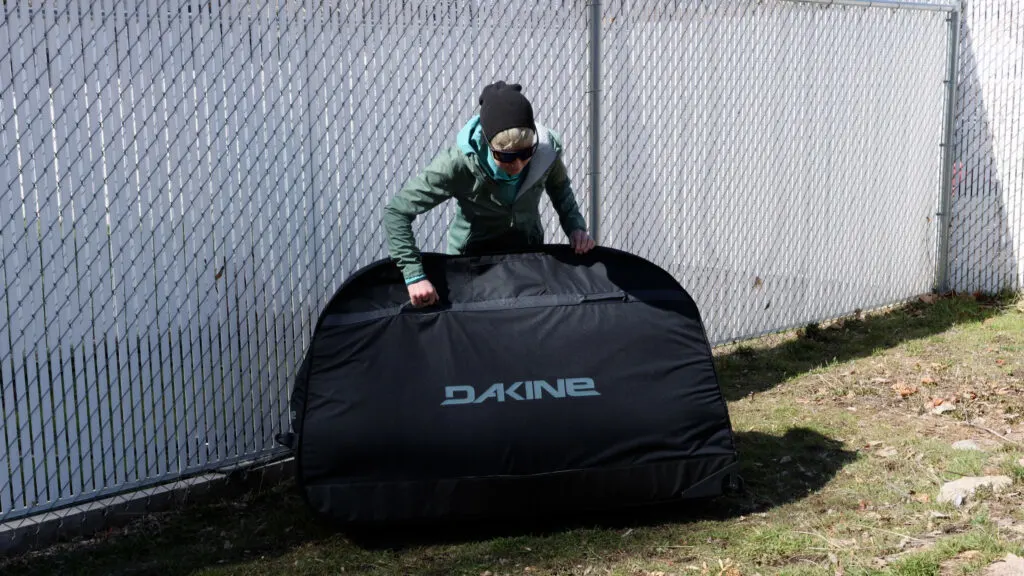
Dakine Bike Roller Bag
A true soft bike bag, The Dakine took a bit more time the first go-round trying to figure out what buckles and straps were supposed to go where and how to position the included foam block to support the frame, but once I had everything in there, it all felt pretty secure and I had no problem doing it again in less than 10 minutes when it came time to travel home. And despite the soft sides, my bike didn’t get dinged or dented in transit.
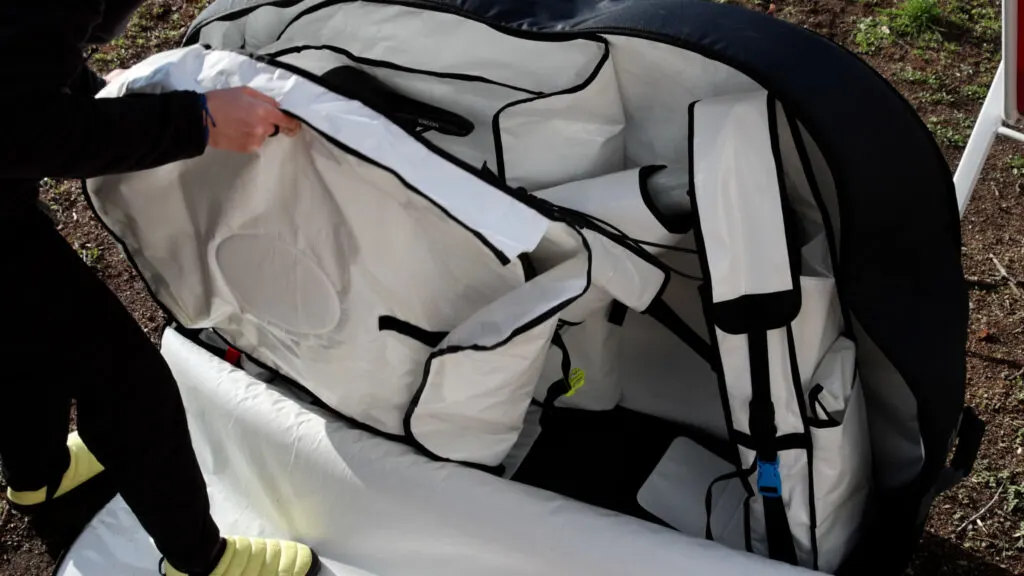
Pros
- At 18lbs, this bag is lighter, meaning when used to pack my mountain bike, which is 28lbs, I was able to squeeze at just under max weight limits when I packed just a small set of tools in the bike bag with my bike.
- The bag is made of 100% recycled materials.
- Easy to pack and unpack a bike after one trial run.
- Protective sheathing.
- Several pockets.
- Durable and comes with a 10-year warranty.
- More affordable ($500).
Cons
- It was a pain to pull around the airport. It was heavy and kept running into the back of my leg because there’s no leash or extendable handle on it.
- Doesn’t offer quite as much protection at a harder-side case.
- Tricky to figure out how to mount the frame in the bag initially.
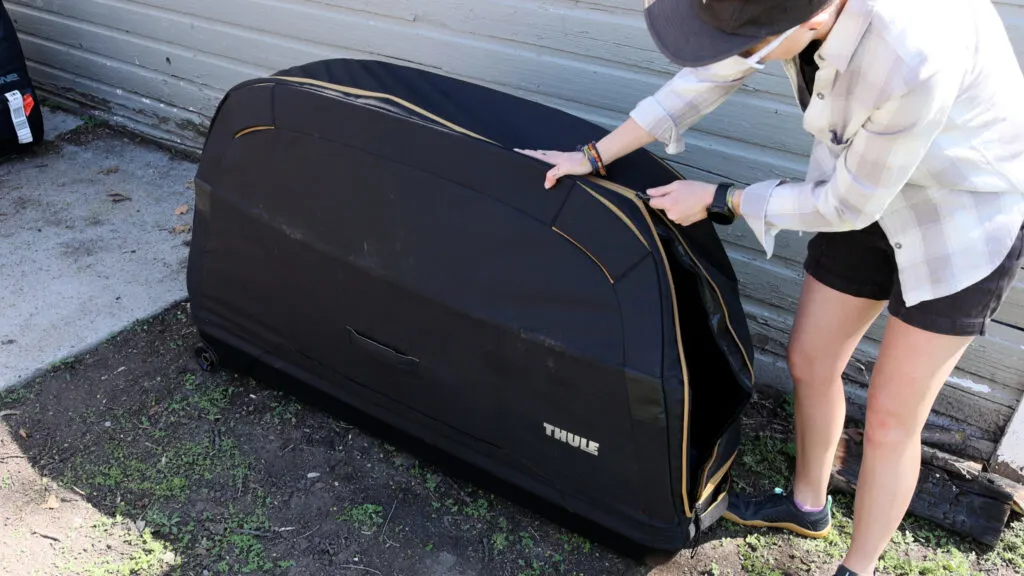
Thule RoundTrip MTB
Then we have The Thule RoundTrip. Which is kind of a cross between a hard and soft case. That’s because it collapses like a soft case, but has semi rigid side panels to help protect your bike a bit more than a traditional soft case during transport. The Thule has a built-in stand on which you mount your bike outside the bag, take off the handlebars, and then move the whole frame, still attached to the top of the stand, from the tripod legs to clip-in points on the bottom of the bag.
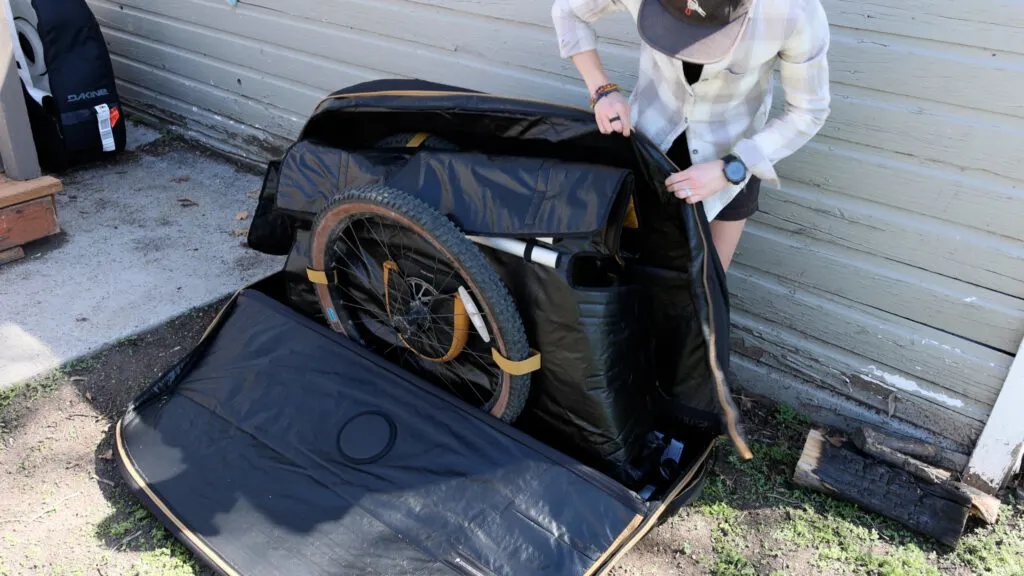
Pros
- Semi-rigid sides kept my bike more protected from rough handling.
- A built-in stand made it slightly easier to dis-assemble and re-assemble my bike.
- Thanks to a removable caster wheel, the bag was much easier to roll through the airport.
- Protective sheathing.
- Several Pockets.
Cons
- The Thule bag is heavy at 30lbs, which put my bike in the overweight category without a single extra piece of gear in the bag.
- The stand was too tall for me and not adjustable, plus can only be used with the front wheel removed.
- The bike rail is hard to remove when a frame is mounted without significant upper body strength.
- Expensive ($999).
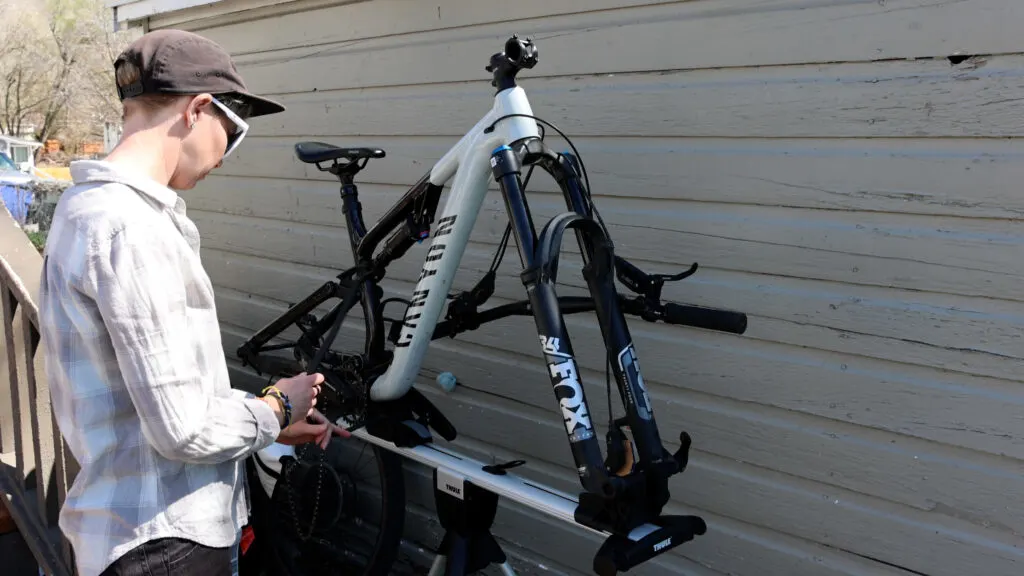
Bottom Line: Which Bike Bag Would I Choose?
Well, my situation being what it is, as in, since my mountain bike is a bit on the heavier side, I’m going with the Dakine just because I absolutely do not want to pay an exorbitant overweight fee every time I travel with my bike. And honestly, my bike isn’t that expensive–comparatively speaking, of course.
That said, if I did have a carbon frame, or a more expensive bike that I was committed to protecting at all costs, I think the Thule bag would be the right choice.
Basically, it depends on you and your bike. The Thule may be heavier and more expensive, but It will definitely offer more peace of mind when it comes to protection–without the rigidity and storage space requirements of a hard case.
The Dakine might not seem as protective, but it did just fine at getting my bike to and from Texas without any problems, plus it was lighter and didn’t require as much of an investment upfront.
But tell us what you think. Do you have one of these bags? Are you thinking of getting one? Let us know in the comments below! I’m super curious to hear which features are more important to you.
Either way, pack up your bike, take it with you the next time you head to Whistler or Bentonville or Fruita, and wander on.
Looking for more travel and MTB content? Find our favorite MTB gear here, and learn whether you can use a backpack as a carryon in this post!
Alisha is a freelance outdoor journalist and photographer based in Ogden, UT. She loves backpacking, hiking, mountain biking, kayaking and snowboarding (even though she’s terrible at it). She’s also pretty sure she’s addicted to coffee. alishamcdarris.com
